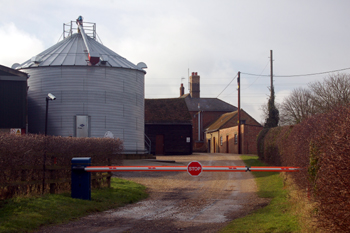
Wood End Farm January 2010
Westoning Wood End Farm formed part of the Trevor Battye family's Tingrith Estate and was put up for sale by auction in 1918, along with Cottage Farm, Redcaps and a large number of other properties. The farm comprised 146 acres, 2 roods, 15 poles and was leased to W. E. Hunt for £202 per annum. The land comprised 107.533 acres in Westoning and 39.062 acres in Tingrith.
The farm was described [Z720/1/28] as follows: "The Substantially Brick Built and Slated Farm House Contains: - Hall, Two Sitting Rooms, Pantry, Larder, Cellar, large Dairy, Kitchen, with Pump from underground soft water Tank, and outside W. C. Flower and Vegetable Gardens. Orchard".
"The Homestead Comprises brick and tiled Brewhouse (used as cooling house) with Pump from Well, Coach House, Meal House and Loft. Timber and tiled Cow House, for 14 cows with feeding passage, Barn, Loose Box, Four-bay open Hovel, Nag Stable for two horses, Three Pigsties, Three-bay Open Hovel, Loose Box, Large Barn, Five-bay Open Hovel, Cart Stabling for four horses, Chaff House, Two Hen Houses, Coal Barn, Open Shed, Nine-bay Open Hovel, Four-bay ditto and Seven-bay Cart Hovel. Three Stock Yards with Water Supply. Rick Yard".
"The Farm which has long road frontages includes some excellent grass land and highly productive arable of an easy-working nature suitable for market gardening, and there is a capital gravel pit in Enclosure No. 228".
The Rating and Valuation Act 1925 specified that every property and piece of land in the country had to be assessed to determine its rateable value. Like much of Bedfordshire, Westoning was valued in 1927 and the valuer visiting Wood End Farm [DV1/H16/76] noted that it was owned by S. Hubbard and occupied by W. E. Hunt. The farm comprised 165 acres and rent had been £240 since 1918, having been £220 from 1916 to 1918. These figures do not compare with those in the auctions of 1918 and 1932 [see below] and may include land which was not considered strictly part of the farm.
The concrete, brick and slate farmhouse comprised two reception rooms, a kitchen, pantry and cellar with four bedrooms and a bathroom above. An earth closet stood outside and the valuer noted that there was "no light", presumably meaning electric lighting. Water came from a pump in the yard.
The homestead contained the following:
- North Block: brick, wood and tiled cow house for fourteen beasts was a passage;
- East Block: a brick, wood and tiled chaff house;
- South Block: a brick, wood and tiled seven bay open cart shed; a cow house for five beasts; a four bay open shed; a fattening house; a brick, wood and asbestos barn and a wood and tiled loose box;
- West Block: a brick, wood and tiled three bay open shed; a stable for eight horses; two loose boxes; a four bay cart shed; a five bay cart shed; two brick, wood and tiled calf boxes and two wood and tiled hen houses;
- Centre Block: a brick, wood, tiled and slated three bay open shed; three pigsties and two loose boxes.
In 1932 Wood End Farm was again up for sale as part of the Tingrith Estate [X511/1]. The description was now as follows: "The Attractive Farmhouse is substantially built brick and slated, and contains: Hall, Dining Room, Sitting Room, 4 Bed Rooms and Bath Room, Pantry, dairy. Outside Coal Barn, W. C. Garden and Orchard".
"The Homestead mainly built of brick, timber and tiled, comprises: - Cow House, tyings for 18 cows with feeding passage, Two Loose Boxes, Milk House, Garage, Granary, Barn and Chaff House. Another Cow House for 5 cows, Nine-bay Open Cart Hovel, Three-bay Open Hovel, Calf Pen, Large Barn, Four-bay Open Hovel, Four-bay Open Cart House, Five-stall Stable, Two Fowlhouses, Three Stock yards with water, Rick-yard".
"Water is pumped to tanks in the roof and thence piped to the buildings". The farm was now let to R. P. Burton at £204 per annum. The land now comprised 145 acres, 1 rood, 39 poles.